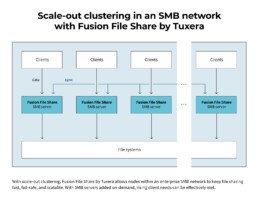Scale-out active-active clustering is the most important tool for achieving scalability in enterprise networking. We provide an overview of how the feature works in practice, and the role it plays as part of Fusion File Share by Tuxera – the world’s most scalable SMB implementation on Linux.
In enterprise file sharing, there is a growing need to accommodate rapidly changing numbers of clients and servers. Businesses may experience sudden surges in client traffic – straining the server bandwidth, or even temporarily crippling enterprise operations. This is especially true in industries like Media & Entertainment (M&E), where the file sharing among many clients results in high workloads that put strain on the SMB sharing being used.
In such a situation, not being able to scale the SMB sharing to the demands can cause significant problems. It can lead to availability issues, slowing down of workflows, important files being inaccessible, server security risks, communications problems and frustration among teams, and more. All of those can cost a business time and money due to lack of file and/or service availability.
Those are challenges which can be avoided, and this is how scale-out active-active clustering can provide huge value to SMB servers.
What is scale-out clustering in SMB and why is it important?
In enterprise networking, scale-out active-active clustering allows an SMB file server to support growing numbers of clients at high speeds. This is an increasingly important capability in enterprise networking, and it can mean successfully avoiding service speed and availability problems that take critical workloads out of action.
In many cases, modern enterprises need to deal with varying (or even somewhat unpredictable) server workloads. I mentioned M&E above, but it’s true across many heavily digitized industries, like high-performance computing and machine learning. With scale-out clustering, an enterprise can be far better equipped to eliminate server downtime, or changes in numbers of clients that need to be serviced, and that allows for much more effective data handling.
Performance also does not suffer – when utilizing scale-out clustering, file throughput remains stable and can in fact be maximized, with the only limit being the network bandwidth.
Related content:
Tuxera’s Fusion File Share SMB server offers novel scale-out feature compatible with Linux.
Overall, scale-out clustering is an important tool to ensure that clients experience the highest performance and continuous availability, and that they are able to keep SMB file sharing uninterrupted when it matters the most.
How does the scale-out clustering feature work?
Scale-out clustering with Fusion File Share by Tuxera
Put simply, scale-out clustering allows an enterprise network to add (or remove) nodes to the SMB and file servers in that network. Then the nodes work together to serve clients of varying quantities. In practice, those numbers of clients can change a lot in real-time, and they can also reach very high numbers (depending on the industry and organization).
With very large numbers of clients, an enterprise SMB network could typically face scalability challenges due to the massive workloads. However, scale-out clustering serves as a “safety valve,” allowing a network to deal with workload and client spikes by adding more nodes as required, and therefore successfully managing client needs.
Fusion File Share by Tuxera is our enterprise-grade SMB implementation that integrates scale-out clustering, and is optimized for performance and availability.
Take a look at the image below for an idea of how an enterprise SMB network using Fusion File Share can flexibly scale to growing client needs.

When dealing with high numbers of clients, the nodes can be added to the network in a theoretically indefinite manner – the network throughput is the real limiting factor. The consistent, linear scaling makes Fusion File Share an excellent choice for accommodating potentially very large client amounts.
It is also important to emphasize that scale-out clustering does not negatively affect performance. With Fusion File Share, the nodes work together to help scale clients in parallel, consuming less CPU and memory than other SMB alternatives.
Scale-out clustering is particularly effective when combined with other useful SMB features, which we plan to talk more about in the future. Alongside RDMA, failover, encryption, and more, Fusion File Share offers an impressive level of performance, scalability, security, and fail-safety.
Final thoughts
Without the most cutting-edge scalability tools, an enterprise SMB network can be left unprepared to deal with server and client needs. Scale-out clustering improves scalability by allowing nodes to be added or removed from a network on an “as needed” basis, ensuring that client needs are met in a flexible way, while keeping performance high. Scale-out clustering is just one feature out of many that work together synergistically, helping to provide the unparalleled performance and fail-safety that Fusion File Share is known for.
Attain unsurpassed scalability in enterprise SMB with Fusion File Share by Tuxera.


